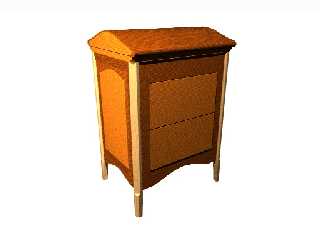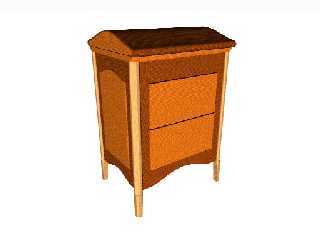|
 |
Hi and thanks for the info.
In rating myself, I know I'm a LONG way from some of the experts here, given
what I have seen (lots of positive challenges ahead), but my strong math and
programming skills suggest that I'm a reasonably capable newbie.
Where I'm having some troubles is in fine-tuning things such as lighting.
Therefore I appreciate your comments that .... "you'd do this, this & that"
as a matter of *your* standards. In other words it works for you and it's
worth sharing the experience. YMMV, as they say.
I just re-lighted what was to be my last image of the night, and now the
last and second-last are attached for your consideration.
I just changed the Z component without regard to the direction of the
lights, so the cabinet is lit differently in each picture. I didn't mean for
this to become a comparison, but, the lights in picture 8 are further away
are at z*-300 and intensity of 1.0
light_source { < -30, 10, -300> color rgb <1.0,1.0,1.0> }
light_source { < 0, 20, -300> color rgb <1.0,1.0,1.0> }
while the lights in picture 7 are close to the chest at z*-30 and intensity
2.0:
light_source { < -30, 10, -30> color rgb <2.0,2.0,2.0> }
light_source { < 0, 20, -30> color rgb <2.0,2.0,2.0> }
Does anyone typically use an intensity (light colour) greater than 1.0? I
just tried this to get more light into the picture. Both scenes are lit with
the above lights and a sky sphere. This is getting better, although I do
like the highlight on the front left leg from the close-in light.
I have been tending to put lights reasonably close but quiet happy to move
them to 500-1000 units away based on a 30x30x30 object (or a 3x3x3 as you
suggested). I'm wondering if the wood-textures I'm using are part of my
issue. Usually I use {Green} when I'm prototyping or {Red & Blue & Yellow}
and these colours tend to show up well.
I don't intend to go so far as the photorealistic lighting i.e. falloff,
etc, unless I have a specific project in mind, but thanks for pointing me in
that direction for future reference.
I didn't mean to turn this conversation into such a long one, but I do
appreciate suggestions such as you have provided.
best regards
Stephen
--
Stephen
and
Kathie
(S+K)
"Mike Thorn" <mik### [at] realitycheckmultimedia com> wrote in message
news:41c50d30$1@news.povray.org...
> Stephen wrote:
> > Thanks for the feedback.
> >
> > But the reason I was using three lights was to get **enough**
illumination.
> > Just one light doesn't seem to cut it, so I'm wondering if there's
something
> > basically wrong in my approach or system.
> >
> > So the question would be - in any typically arbitrary scene such as
modeling
> > a TV or a plant or a table or desk, can you illuminate the scene with
one
> > light source which would approximately simulate one 100W lightbulb in
the
> > room, at 6-18 feet away?
> >
> > My answer would be - nope- need multiple lights. What's that tell you?
> >
> >
> > I'll try the gamma correction right now.
>
> From an advanced newbie...
>
> Realistically simulating lamplight (or any other kind of real-world
> light source) in POV-Ray is a good deal more complicated than simply
> defining a light source at a certain distance, with a certain
> value/intensity, and hoping for the best.
>
> First of all, a default light source has no falloff. The light rays will
> be equally bright whether they're 100 units away or 10,000 units. The
> only difference is how many rays hit the object (since a default light
> source emits light in all directions, placing the light source very far
> away spreads the rays out more, thereby making an object *appear*
> darker). In reality, it's just receiving fewer beams.
>
> However, putting your light source very close isn't always the answer
> either, since you'll have high concentrations of light beams in a small
> area, causing washed-out spots.
>
> GrimDude is simply saying that you'll get smoother coverage with your
> lights - the rays will be more spread-out, reducing blown highlights -
> by moving your light sources farther away. I would have said exactly the
> same thing myself if I had noticed the problem (it really didn't strike
> me). When I'm not trying to achieve photorealism, I quite often put my
> lights 500+ units away, even if my object is only a few units each
> dimension. If I had a very large object, eg. 30x30x30, I would probably
> put my lights even farther, such as 800. That's just how I tend to
> operate, however. If you really want a photorealistic effect, the rules
> all change.
>
> There are ways to make the light sources behave realistically. POV-Ray
> supports light falloff and fading, which, when set properly (an area I
> can't advise on, unfortunately) can produce quite realistic results. If
> you want to look these up, look for the 'falloff' and 'fade_distance'
> keywords in the Help file.
>
> Incidentally, Jaime Vives Piqueres has done some research into the
> physical properties of light and has created some macros for realistic
> light simulation. I am still learning how to use them myself, but you
> might find them interesting. http://ignorancia.org/lightsys.php
>
> Hope this helps somehow. As long as you keep in mind that I'm not an
> expert and thus take all this with a grain of salt, I think you'll be
> okay. :)
>
> ~Mike com> wrote in message
news:41c50d30$1@news.povray.org...
> Stephen wrote:
> > Thanks for the feedback.
> >
> > But the reason I was using three lights was to get **enough**
illumination.
> > Just one light doesn't seem to cut it, so I'm wondering if there's
something
> > basically wrong in my approach or system.
> >
> > So the question would be - in any typically arbitrary scene such as
modeling
> > a TV or a plant or a table or desk, can you illuminate the scene with
one
> > light source which would approximately simulate one 100W lightbulb in
the
> > room, at 6-18 feet away?
> >
> > My answer would be - nope- need multiple lights. What's that tell you?
> >
> >
> > I'll try the gamma correction right now.
>
> From an advanced newbie...
>
> Realistically simulating lamplight (or any other kind of real-world
> light source) in POV-Ray is a good deal more complicated than simply
> defining a light source at a certain distance, with a certain
> value/intensity, and hoping for the best.
>
> First of all, a default light source has no falloff. The light rays will
> be equally bright whether they're 100 units away or 10,000 units. The
> only difference is how many rays hit the object (since a default light
> source emits light in all directions, placing the light source very far
> away spreads the rays out more, thereby making an object *appear*
> darker). In reality, it's just receiving fewer beams.
>
> However, putting your light source very close isn't always the answer
> either, since you'll have high concentrations of light beams in a small
> area, causing washed-out spots.
>
> GrimDude is simply saying that you'll get smoother coverage with your
> lights - the rays will be more spread-out, reducing blown highlights -
> by moving your light sources farther away. I would have said exactly the
> same thing myself if I had noticed the problem (it really didn't strike
> me). When I'm not trying to achieve photorealism, I quite often put my
> lights 500+ units away, even if my object is only a few units each
> dimension. If I had a very large object, eg. 30x30x30, I would probably
> put my lights even farther, such as 800. That's just how I tend to
> operate, however. If you really want a photorealistic effect, the rules
> all change.
>
> There are ways to make the light sources behave realistically. POV-Ray
> supports light falloff and fading, which, when set properly (an area I
> can't advise on, unfortunately) can produce quite realistic results. If
> you want to look these up, look for the 'falloff' and 'fade_distance'
> keywords in the Help file.
>
> Incidentally, Jaime Vives Piqueres has done some research into the
> physical properties of light and has created some macros for realistic
> light simulation. I am still learning how to use them myself, but you
> might find them interesting. http://ignorancia.org/lightsys.php
>
> Hope this helps somehow. As long as you keep in mind that I'm not an
> expert and thus take all this with a grain of salt, I think you'll be
> okay. :)
>
> ~Mike
Post a reply to this message
Attachments:
Download 'Chest36x24x18-Leg7.jpg' (61 KB)
Download 'Chest36x24x18-Leg8.jpg' (62 KB)
Preview of image 'Chest36x24x18-Leg7.jpg'

Preview of image 'Chest36x24x18-Leg8.jpg'

|
 |




![]()